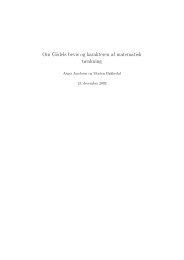Master Dissertation
Master Dissertation
Master Dissertation
Create successful ePaper yourself
Turn your PDF publications into a flip-book with our unique Google optimized e-Paper software.
Chapter 7<br />
Splitting of Numerical<br />
Distributions<br />
7.1 The Singular Order of a Distribution<br />
We expect the operator-valued distributions to be expanded in terms of<br />
free fields as follows1 Dn(x1, . . . , xn) = <br />
: <br />
ψ(xj)d k n(x1, . . . , xn) <br />
ψ(xl) :: <br />
A(xm) :,<br />
k<br />
j<br />
where the numerical distributions d k n ∈ S ′ (R 4n ) have the causal support<br />
property (5.20). We have to assume them to be tempered in order to use<br />
the Fourier transformation. Our aim is to split these distributions<br />
where<br />
d k n(x) = rn(x) − an(x),<br />
supp rn ⊂ Γ + n−1 (xn) and supp an ⊂ Γ − n−1 (xn).<br />
We have assumed translational invariance thus we may assume xn = 0 and<br />
thus only consider<br />
d(x) := d(x1, . . . xn−1, 0) ∈ S ′ (R m ), m = 4(n − 1).<br />
In the Hilbert space setting of our earlier example we would do the<br />
splitting as<br />
rn(x) = χn(x)d k n(x), where χn(x) =<br />
n−1 <br />
j=1<br />
l<br />
Θ(x 0 j − x 0 n) =<br />
m<br />
n−1 <br />
1 Note that the double dots denote normal ordering. See Definition 4.4<br />
2 We write it like this to show what it would be if xn = 0.<br />
49<br />
j=1<br />
Θ(x 0 j) 2 .



